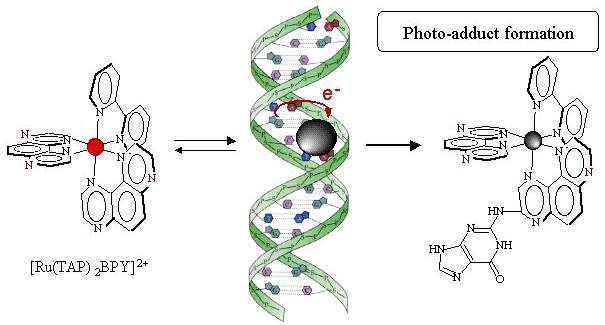
Photoreaction with DNA

Quenching in the presence of DNA
The emission of [Ru(TAP)2BPY]2+ is quenched in the presence of DNA. The quenching of Ru(II) complexes bearing TAP ligands by DNA has been extensivelly studied. This complex present a high reduction potential in the excited state (P*red = +1.06 V vs SCE) and can thus abstract an electron from the guanine bases of DNA (Pox = +0.92 V vs SCE). This photo-induced electron transfer has been evidenced by laser flash photolysis experiments which allow the detection of the radicals formed following the electron transfer [1].
Photoadduct formation
The radicals formed after this photo-induced electron transfer (Ru1+ and Guanine residue1+) can recombine to form covalent adducts. The formation of such adducts can be monitored by UV-visible absorption spectroscopy or by biochemical methods such as gel electrophoresis and dialisys methods [2]. The strucutre of the photo-adducts formed between [Ru(TAP)2BPY]2+ and guanine residue of DNA, isolated by a combinaition of enzymatic and acid hydrolytic procedures in conjunction with HPLC, has been detremined by NMR spectroscopy and electrospray mass spectrometry and is presented on the figure above [3].
This photoadduct formation could lead to potential anti-cancer agents. Indeed, the basis of the action of the chemotherapeutic drug cis-platin is the formation of adducts with DNA, where Pt is complexed with a nitrogen of one of the DNA bases. The critical advantage of Ru(II) complexes lies in that they become active only under illumination and their activity could thus be controled by light.
[1] J.P. Lecomte and A. Kirsch-De Mesmaeker, M. Feeney and J. Kelly, Inorg. Chem., 1995, 34, 6481-6491
[2] M. Feeney, J. Kelly and A. Tossi, A. Kirsch-De Mesmaeker and J.P. Lecomte, J. Photochem. Photobiol. B: Biol., 1994, 23, 69-78
[3] L. Jacquet, R. Davies, A. Kirsch-De Mesmaeker and J. Kelly, J. Am. Chem. Soc., 1997, 119, 11763-11768